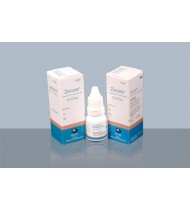Antazoline Hydrochloride + Tetiyzoline Hydrochloride
Indications
Temporary relief of the signs and symptoms of allergic conjunctivitis including conjunctival hyperaemia, chemosis and itching in adults and children above 2 years of age.
Pharmacology
Antazoline is an anti histamine of the ethylenediamine class, which are selective H1-antagonist. Effects mediated by H1 receptors include the contraction of smooth muscle and the dilation and increased permeability of the capillaries.
Antihistamines, which act by blocking the H1 histamine receptor, are highly effective in providing relief of itching but are not very active in relieving the associated redness. The use of products combining an anti-histamine and a vasoconstrictor is well established in the symptomatic relief of allergic eye disease.
Tetryzoline is a sympathomimetic with alpha adrenergic activity. Its vasoconstrictive effect reduces redness and oedema in allergic conjunctivitis.
Antihistamines, which act by blocking the H1 histamine receptor, are highly effective in providing relief of itching but are not very active in relieving the associated redness. The use of products combining an anti-histamine and a vasoconstrictor is well established in the symptomatic relief of allergic eye disease.
Tetryzoline is a sympathomimetic with alpha adrenergic activity. Its vasoconstrictive effect reduces redness and oedema in allergic conjunctivitis.
Dosage & Administration
Adults and adolescents: 1 drop 2 to 3 times daily upto 14 days. Children Colder than 2 years of age): No specific studies are available in this patient group. For possible systemic effects, the dosage should exceed to 1 to 2 drops per day. Not to be used in children below 2 years of age.
The eye drop should not be used for longer periods than 14 days as this may cause rebound hyperaemia and toxic follicular conjunctivitis.
The eye drop should not be used for longer periods than 14 days as this may cause rebound hyperaemia and toxic follicular conjunctivitis.
Interaction
Sympathomimetic agents may cause a hypertensive crisis if used during treatment with MAOIs. Concomitant use with MAOIs is therefore contraindicated.
Sedating anti-histamines can enhance the sedating effects of CNS depressant including alcohol, hypnotics, opioid analgesics, anxiolytic sedatives and anti-psycotics. They also have an additive anti-muscarinic action with other anti muscarinic drugs, such as atropine and antidepressant
Sedating anti-histamines can enhance the sedating effects of CNS depressant including alcohol, hypnotics, opioid analgesics, anxiolytic sedatives and anti-psycotics. They also have an additive anti-muscarinic action with other anti muscarinic drugs, such as atropine and antidepressant
Contraindications
Known hypersensitivity to Antazoline/ Tetryzoline or to any of the excipients. Concomitant use with Monoamine Oxidase Inhibitors (MAOI).
Side Effects
The most common adverse effect is burning/stinging upon installation, which is mild and transient in nature.
Pregnancy & Lactation
Use in Pregnancy: No clinical data on exposed pregnancies are available. The eye drops should only be used if the potential benefits outweigh the risks to the fetus or infant.
Use In Lactation: It is not known whether the either of the active substances of the eye drop passes into breast milk. Caution should be exercised when using the product during breast-feeding.
Use In Lactation: It is not known whether the either of the active substances of the eye drop passes into breast milk. Caution should be exercised when using the product during breast-feeding.
Precautions & Warnings
The eye drop should be used with caution in elderly patients with severe cardiovascular disease, including arrhythmia, poorly controlled hypertension or diabetes.
Overdose Effects
A topical overdose of this ophthalmic solution may be flushed from the eye with warm tap water.
Therapeutic Class
Other ophthalmic preparations
Storage Conditions
The drug is to be used within 30 days after first opening. Store at 15-25° C. Protect from light. The bottle is to be closed strongly immediately after use.
Opthamet Ophthalmic Solution 10 ml drop
IndicationsTemporary relief of the signs and symptoms of allergic conjunctivitis including conjuncti..
110.35Tk.
Spersallerg Ophthalmic Solution 10 ml drop
IndicationsTemporary relief of the signs and symptoms of allergic conjunctivitis including conjuncti..
113.78Tk.
Zocare Ophthalmic Solution 10 ml drop
IndicationsTemporary relief of the signs and symptoms of allergic conjunctivitis including conjuncti..
115.00Tk.
Showing 1 to 3 of 3 (1 Pages)


%20Limited/Spersallerg%20Ophthalmic%20Solution%2010%20ml%20drop-190x210.jpg)
